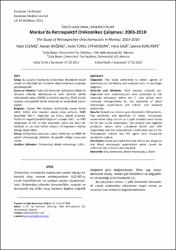Manisa'da retrospektif onikomikoz çalışması: 2003-2010
Özet
Amaç: Bu çalışma Manisa’da onikomikoz etkenlerini tespit etmek ve mikolojik tanı testlerini değerlendirmek amacıyla gerçekleştirildi. Gereç ve Yöntem: Yedi yıllık dönemde onikomikoz klinik ön tanısıyla mikoloji laboratuvarına sevk edilerek direkt mik- roskobik bakısı (DMB) ve kültürü yapılmış 3518 kişinin kayıt- ları retrospektif olarak incelendi ve istatistiksel analizi yapıl- dı. Bulgular: Toplam 940 hastanın kültüründe üreme tespit edildi. Kültür altın standart olarak kabul edilerek, DMB duyarlılığı %87.7, özgüllüğü ise %52.2 olarak bulundu. Pozi- tif ve negatif prediktif değerler sırasıyla %40.1 ve %92 he- saplandı ve her iki test arasındaki uyum ise %61.7’di. Kül- türde en sık izole edilen etkenin Trichophyton rubrum oldu- ğu tespit edildi. Sonuç: Onikomikoz tanısı için sadece klinik tanı ve DMB’nin yeterli olamayacağı, kültürün de gerekli olduğu sonucuna varıldı. Objective: This study performed to detect agents of onychomycosis in Manisa and evaluate tests of mycologic diagnosis. Material and Methods: 3518 persons clinically pre- diagnosed with onychomycosis who presented to the mycology laboratory within the 7- year period were reviewed retrospectively for the outcomes of direct microscopic examination and culture, and analysed statistically. Results: Growth on cultures were detected in 940 patients. The sensitivity and specificity of direct microscopic examination using culture as a gold standard were found 87.7% and 52.2% respectively. The positive and negative predictive values were calculated 40.1% and 92% respectively and the concordance in both tests was 61.7%. Trichopyhton rubrum was the agent most frequently isolated on culture. Conclusion: It was concluded that only clinical pre-diagnosis and direct microscopic examination alone cannot be sufficient and culture is also required.
















